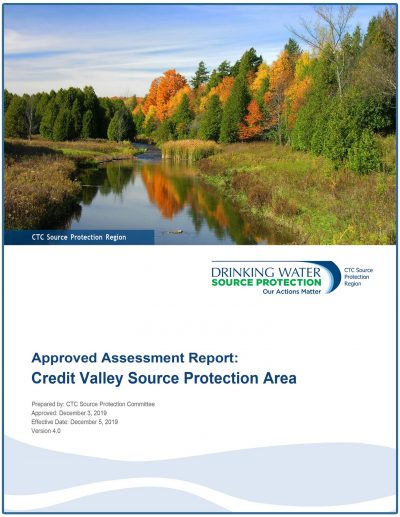This report describes the physical features and water resources within the Credit Valley Source Protection Area jurisdiction. Using approved provincial methodologies, it delineates vulnerable areas and assesses specific activities that pose potential drinking water threats within these vulnerable areas.
Where drinking water threats have been identified as significant, the Source Protection Plan outlines what policies will apply.
Note to readers: The Assessment Report documents linked below are the amendments to the Credit Valley Source Protection Area Assessment Report approved on December 3, 2019 and that came into effect on December 5, 2019. Following June/July 2023 public consultation, the most recent amendments to the Credit Valley Source Protection Area Assessment Report were approved on February 29, 2024 and came into effect on March 6, 2024. The 2024 amended Assessment Report will be posted here in the near future. Please contact us with any interim questions regarding the recently approved amendments.
Download the Report by Chapter
- Cover, Preface, Executive Summary and Glossary
- Chapter 1 provides a brief overview of the provincial context for source water protection, previous work done on this issue, and the goals of the source water protection planning process.
- Chapter 2 describes the physical and human characteristics of the Credit Valley Source Protection Area jurisdiction, including its physiography, geology, hydrology, terrestrial and aquatic ecology, human characterization, water quality, and water uses.
- Chapter 3 summarizes the water budget and water quantity stress assessment.
- Chapter 4 identifies the vulnerable areas required as part of the source protection program within the study area.
- Chapter 5 describes how drinking water threats and issues were identified and lists threats within Credit Valley Source Protection Area’s jurisdiction.
- Chapter 6 summarizes the Assessment Report contents and next steps.
- Chapter 7 provides a list of references, which includes a number of technical reports prepared by consultants.
Appendices
- Appendix A provides a description of the Data Sources.
- Appendix B provides additional information for Chapter 2 on the Watershed Characterization data gaps and supplementary water quality data.
- Appendix C documents the methodologies employed in the development of understanding the water supply and demand across the Credit Valley Source Protection Area.
- Appendix D provides additional documentation of the Vulnerable Areas assessment process including the MOE Technical Bulletins on vulnerability.
- Appendix E includes the MOE Technical Bulletin for the threat assessment process as well as output from the South Georgian Bay Lake Simcoe conformance exercise on the enumeration of threats, summaries of the municipal threat assessment reports prepared for municipalities and a summary of the work completed for the Lake Ontario Collaborative for the assessment of threats to Lake Ontario drinking water intakes.
Significant Threats
With respect to surface water, Lake Ontario modelling identified 3 significant drinking water quality threats related to Lake Ontario intakes within the Credit Valley Source Protection Area. In addition, 18 significant drinking water quality threats to local Lake Ontario intakes from activities outside the Credit Valley Source Protection Area were identified.
With respect to groundwater, 9,553 significant drinking water quality threats have been identified in this Assessment Report. Drinking water issues relating to sodium (Na) and chloride (Cl) were identified in WHPAs of municipal wells servicing the Towns of Orangeville, and issues related to chloride were identified for municipal supply wells for the Town of Georgetown.
Issues relating to Nitrates (NO3) were found in municipal wells servicing the Town of Acton. A drinking water issue relating to pathogens was also identified for a municipal well servicing Inglewood. These are areas in the middle and upper zones where sizeable populations receive municipal water supplies sourced from the ground.
The Tier 3 Water Budget work has also identified 392 significant drinking water quantity threats at Orangeville, Mono, Amaranth, and Acton.

